The Celery Farm
One of my site visitors, Gabriele, mentioned that I should visit a place in North Jersey called the Celery Farm. On the day before Father’s Day, I did.
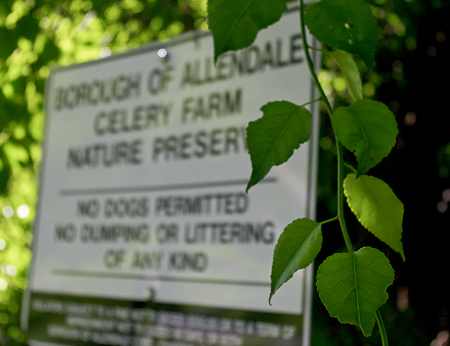
© Native Bergen
A sure ‘sign’ that I successfully located the Celery Farm. The sign though; not the massive growth of Asian Bittersweet (Celastrus orbiculatus) devouring everything in its path.
As the name suggests, the plot of land was once used to grow celery. Now, its a 107-acre wetland sandwiched in a suburban pocket of tony Allendale, New Jersey. This green space has a unique set of features, most notably, water: two ponds, diminutive Lake Appert and the Allendale Brook. It’s a prime location for birds; 53 species that use it as a breeding ground and almost 250 species that have been seen there. On my visit, I saw chipmunks, rabbits, toads, and Canadian Geese. There are a couple of trails in the place; one in particular that makes just under a one mile ring that will allow you to see the lake and a good bit of Allendale Brook.
The GPS-furnished directions led me to a narrow cul-de-sac with affluent homes on one side and thick vegetation on the other. The green side had official looking signs indicating that this was protected land, but no entrance. This street looked way too neighborhood-watchy for me to just park on the side of the road so I decided to search adjacent streets for an entrance. Just around the corner I found an official entrance with a small parking lot and a well appointed kiosk.
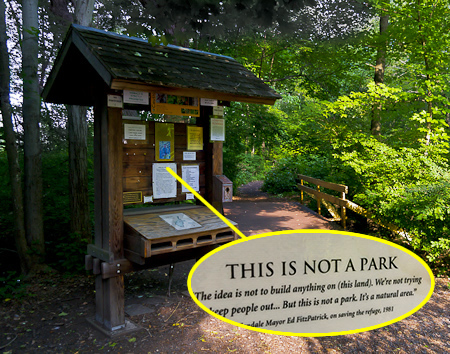
© Native Bergen
This ain’t no disco! —or park for that matter.
As the sign suggests, this parcel of New Jersey is mostly for non-human consumption. We are allowed to visit much in the same way that you might allow birds to visit your front and backyard. The trail is well-marked, even enhanced in areas but only to keep us from destroying the surrounding nature in our efforts to not get mucky. Many visitors may find themselves saying, ‘Where is the punchline?” The idea here is to let nature do its thing; unhindered by the likes of us.
Immediately, I started making mental comparisons to the Hilltop Reserve over in Essex County: both locations have the distinction of being a tiny nature oasis in a desert of suburban sprawl. Both locations are also adamant about the land belonging to animals and plants, not humans. The Celery Farm delivered this message right out of the gate, literally. Before I could read any of the other treehugger lit, I could clearly see one placard with bold print yelling , THIS IS NOT A PARK and then a litany of do’s and don’ts. Make no mistake, this is a good thing.
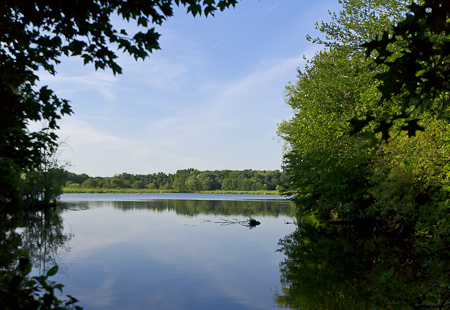
© Native Bergen
To make a public space agreeable with nature, you have to consider the human animals that will visit the place with or without authorization. The Celery Farm does a great job of guiding its human visitors. There was even a sign telling joggers to simmer down. That if they continue to jog through the vegetation to get around walkers —they would be banned all together. The location has three observation platforms, elevated wooden structures located around the lake to allow humans to view and photograph the natural resources in the preserve. This is a fantastic idea. From the platforms, I obtained a visual perspective of the entire site. The palpable desire to tramp off the designated path into the vegetation was eliminated. There are many signs and guidance all throughout the preserve. Maybe not the most romantic touch but definitely vital for the Celery Farm’s continued survival.
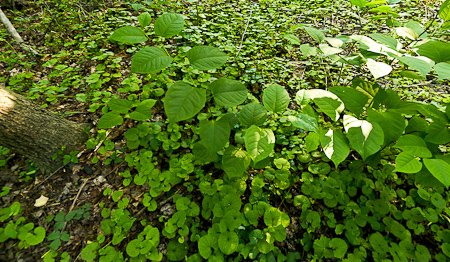
© Native Bergen
Three aggressive exotic species fighting it out in suburban NJ: Japanese Knotweed (Fallopia japonica), Garlic Mustard (Alliaria petiolata) and Japanese Spurge (Pachysandra terminalis)
On the downside, the site was rife with invasive species. There were huge swaths of Japanese Knotweed, multiflora rose, garlic mustard, Asian bittersweet, Norway Maple and even that heinous front yard staple, pachysandra. I’d also bet money that the phragmites, at 6-7 feet tall and inundating the place; were the ambitious European variety. This was disappointing, for me. Not an indictment against the preserve but instead the entire state of New Jersey and our own human tendencies.
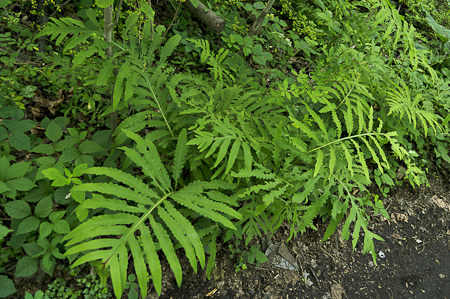
© Native Bergen
Sensitive Fern (Onoclea sensibilis) , Poison Ivy (Toxicodendron radicans), Virginia Creeper (Parthenocissus quinquefolia) and even a bit of Skunk Cabbage (Symplocarpus foetidus) all New Jersey native plants in a stunningly boring photo.
On the native side, I do remember ferns. Ample patches of sensitive ferns and what looked like either cinnamon ferns or marsh ferns. There was also arrowwood viburnum in bloom. There were plenty of native trees but my eyes were mostly glued to the forest floor since the site is very swampy and I was not tick/lime disease prepared. These were the natives I noticed. Although there were a lot of exotic invasives, the native plants are there; the intrepid visitor will find them.The ferns were also wonderful to see considering how rarely they are found outside of places like the Celery Farm.
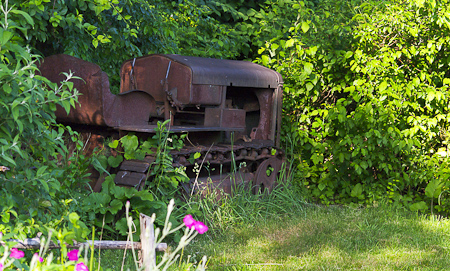
© Native Bergen
Rusted out tractor: definitive proof that this plot of land used to be a Celery Farm.
The Celery Farm is a must-see for people interested in the wilder sides of North Jersey. I really saw the challenges and potential of creating a green space in the most densely populated state. The concentrated graft of native plants that are now flourishing in the Hilltop Conservancy is impressive in light of what I saw in Allendale.
When you walk through the Celery Farm you find yourself saying, “This place is amazing. What could it be like with more volunteers, less exotics, and no suburbs?”
On the other hand, the Celery Farm is a Mecca for birds and animals that are dwindling in so many other parts of the state. My survey was by no means exhaustive. Visit the Celery Farm online to see lists of all the plants and animals available there.
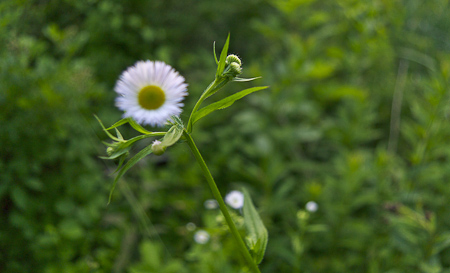
© Native Bergen
Erigeron strigosus (Prairie Fleabane), a New Jersey native plant that’s also indigenous to a good portion of the continental U.S.
When you visit, don’t do like I did. I spent the whole time looking for that special something. I’m quick to poo-poo about the people going to nature preserves and asking where are the picnic tables and BBQ grills. I’m guilty in my own way of the same sort of thing. I had this fantasy that I would see eclectic plants and animals and a pristine environment the likes of which haven’t been seen in New Jersey in almost 200 years. The treasure is the preserve itself; maybe dull, mucky, brown and green to humans; but diamonds and platinum to the animals that flourish there.
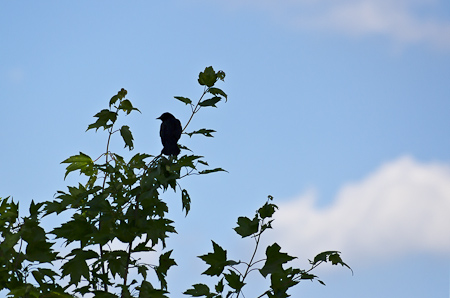
© Native Bergen
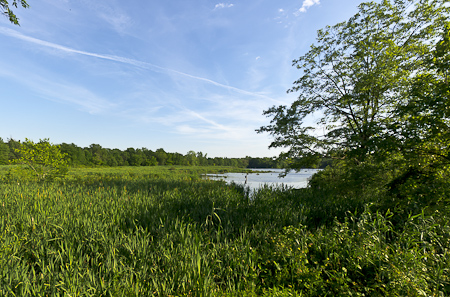
© Native Bergen
You’re going to feel the very human urge to cut flowers or pick up a walking stick; don’t. Scratch that itch with a good camera. Photograph as much you like but please stay on the paths. If you really want to kill the ‘mess with it’ urge, contact the Fyke Nature Association and make a donation or volunteer. Trust me, your results will be greater than what you put in. Just like eating celery.July 6, 2012|Posted in OUTSIDE, PLACES|Tags: Allendale, Celery Farm, invasive species, native plants, nature preserve| |












4 Comments
Cool man I forgot about this place. I've walked around the lake there a couple times. I'm very glad this place is preserved. The swampiness reminds me of some state parks I've been to in South Jersey and Delaware. Charlie July 9, 2012 at 10:56 am
Hey Charlie! Great to hear from you! I hope I wasn't too critical in this post because you're right, the swampiness of this site really makes you forget your in North Jersey. Between the wetness of the place and the ferns everywhere the CF really does have a different feel than a typical Jersey park. Before the summer is out, I need to catch up with you to see your permaculture garden and your friend's as well. Also, real soon I'll be posting a piece about a woman in Maywood, NJ who does an ornamental plant version of what your doing. Stay tuned. óNativeBergen July 9, 2012 at 12:18 pm
I enjoyed reading this. Can you provide a link to a Celery Farm plant checklist? Patrick Carney October 2, 2013 at 11:06 am
Link to a plantlist? This is a fantastic request! —fantastic becuase to my knowledge, there is no official plant list for the Celery Garden. At least nothing I could find doing a cursory web search. A list seems like an excellent resource to have available. I was wandering through the Palisades Interstate Park in Alpine, NJ last weekend and saw a bunch of interesting plants and could find no plant list for that park either. Sounds like a golden opportunity for NativeBergen. I'll get right on that. óNativeBergen October 3, 2013 at 1:23 pm